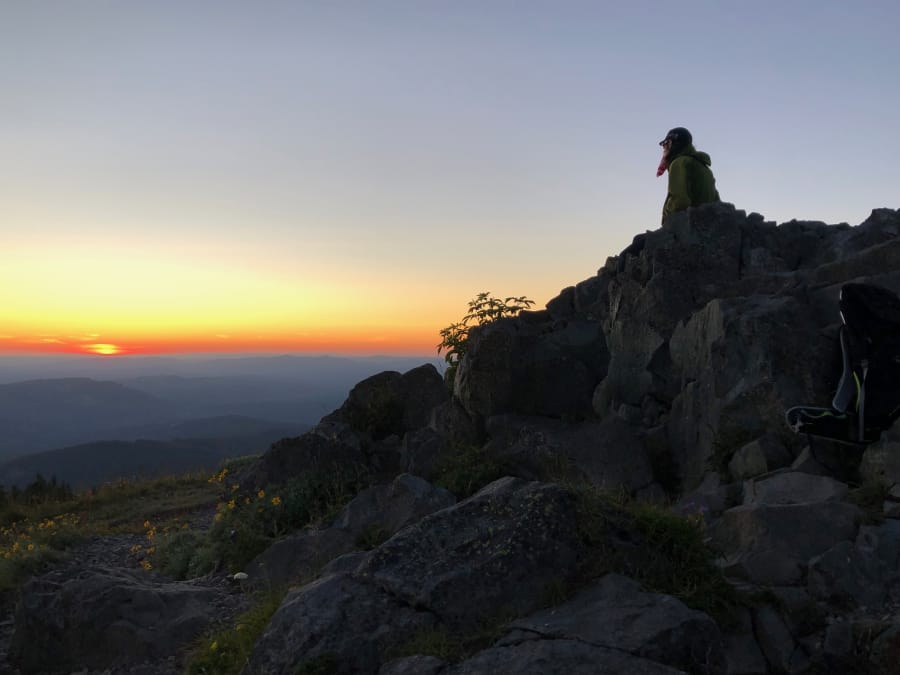The Cascade volcanoes are plenty majestic in broad daylight.
In twilight, the peaks take on an otherworldly rosy hue.
Southwest Washington has one of the best spots to view no fewer than five of the Cascade Range’s most iconic peaks.
From Silver Star Mountain’s 4,382-foot summit, Mount Rainier, Mount Adams, Mount St. Helens, Mount Hood and Mount Jefferson can be seen unobstructed.
From Rainier at the Puget Sound’s doorstep to Jefferson above the Central Oregon desert, it’s a panorama that stretches more than 150 miles.
The view from atop Silver Star is majestic any time of day. But hikers who pack a headlamp and a jacket can find one of the Northwest’s best sunset scenes just 25 miles as a crow flies from downtown Vancouver.
And for a hike that descends in the darkness, Silver Star is remarkably accessible.
Approaching from the north on Silver Star Trail No. 180, hikers reach the summit on a six-foot-wide former gravel road. It’s 2.5 miles each way with an evevation gain of just over 1,200 feet.
Two notes of caution. Forest Service road No. 4109 to reach Silver Star’s north trailhead is deeply rutted and suitable only for high-clearance vehicles with four-wheel drive. Also, most of the rocks on the trail to the summit are baseball-sized ankle-twisters.
But with sturdy boots and treking poles, Silver Star and its gorgeous sunset scenes are there for the taking. On a recent Saturday evening, six fellow hikers were atop the summit at sunset, including two who had set up single-person bivy tents.
A few of those hikers stayed until after dark to see Comet Neowise, which should be visible in the northwest sky for the rest of July.
Even before the sun sets, there’s plenty to see on the trail up Silver Star’s treeless north slope. Wildflowers flourish in the summer. Scarlet paintbrush, purple broadleaf lupine and yellow Oregon sunshine serve up a colorful foreground to any of the trail’s expansive vistas.
After 0.3 miles, hikers can choose to take Ed’s Trail, which hugs the east-facing slope of Silver Star’s northern ridge. Trail No. 180 is slightly shorter and safer for a return trip that will be mostly in the dark.
About a quarter-mile from the top, a manmade gravel pyramid marks the spur trail to the summit. The top is a rocky outcrop that includes the concrete footprint of a former fire lookout.
As the sun sets, the stretching shadows bring the ridges of the Columbia River Gorge and the Gifford Pinchot National Forest into sharper relief. The snow-covered heights of Mount Hood fade from trillium white to grapefruit pink.
To the west, the pointed top of nearby Sturgeon Rock appears charcoal black against a backdrop of firey orange. In the distance, the streetlights of Vancouver and Portland sparkle in the lowlands.
With a headlamp and/or flashlight, the return trip on Trail No. 180 is straightforward with no serious chance of losing the trail. The biggest hazard is the rocky footing which can cause an ankle to roll if one gazes too often at the fading glow to the west.
By the time the trailhead was reached, the stars were out. About a dozen stargazers stood in the parking area waiting for Neowise to appear, which it soon did to the naked eye.
Comet or not, Silver Star is a rare sight at sunset that should be on any nocturnal hiker’s list.




